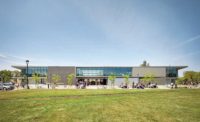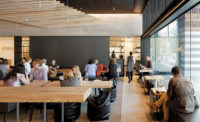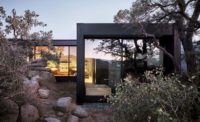The Windhover Contemplative Center at Stanford is a delightful amalgamation: neither a house of worship nor a traditional art gallery, it has an open-ended program that embraces both and more. This secular temple has a decidedly ecumenical approach, offering a space for structured meditation or just quiet observation of art and nature, a reminder that design can be transcendent.
A student, faculty, and staff sanctuary from the rest of campus and daily life (it is only open to the public once a week during a docent-led tour), the 4,000-square-foot building houses a handful of immense canvases from the late painter Nathan Oliveira’s Windhover series, inspired by kestrels in flight. The center, which formally opened in October of 2014, fulfills Oliveira’s dream of a space that isn’t constrained only to display art. Instead, it is like an exquisite modern house, furnished with impeccable contemporary art, that anyone in the university community can use for an instant getaway.Additional Content:
Jump to credits & specifications
An internationally renowned figurative painter, Oliveira joined the Stanford faculty in 1964 and taught art there for more than 30 years. He also served as a student advisor, and became concerned with the amount of stress he observed. On the occasion of his retirement in 1995, he gave a talk about his vision for a contemplative space that could provide some moments of quiet respite. In the audience was a collector of his work, Suzanne Duca, who offered to help fund the center.
It would take nearly two decades for the project to get off the ground; in addition to standard bureaucratic hurdles, its rather amorphous program didn’t fit neatly into the university structure (eventually, it would come under the wing of two offices, religious life and student affairs), and it took a while to settle on a central location that could be easily accessed by students. Oliveira was pleased by the final determination, a former parking lot bordered by a grove of old oak trees, adjacent to student housing. He died in 2012, well before Aidlin Darling Design had been selected as architect. However, his son Joe Oliveira thinks he would have been “overjoyed” by the result. “I know he would have loved the soft quality of the lighting and the calmness of the building,” he says.
Stanford’s strict architecture guidelines, which reference its historical Romanesque quadrangle, have made it difficult for contemporary architects to assert themselves. But Windhover, the Anderson Collection building by Ennead (RECORD, December 2014, page 96), and the Diller Scofidio + Renfro–designed McMurtry Art & Art History building, currently under construction, are evidence that the university is allowing more leeway for buildings designed for art.
Windhover’s long rectangular pavilion has a classic minimalism. But here the lightness of glass and aluminum is juxtaposed with the weight of rammed earth and wood siding. “The rammed-earth walls are like ruins coming out of the ground, which anchor and frame the entry sequence,” says Joshua Aidlin, principal of the San Francisco–based Aidlin Darling. When a wall meets glass, it often extends past it, creating an effortless indoor–outdoor connection; the same is true of the floor, which continues outside to form a deck. Unlike the Rothko Chapel in Houston (1971), which is probably the closest point of reference, Windhover continuously looks outward. “Nathan wanted a very organic space, not a museum but a place of contemplation that valued nature and his paintings equally,” says Aidlin. “It was a dream project—it was like an architectural thesis project, combining architecture, nature, art, and spirituality.”
From the street, it appears as a modest, opaque box, clad in vertical strips of cedar (a “non-facade,” as Aidlin describes it). The front door is set as far away from the road as possible, so visitors travel along a path that runs nearly the full length of the building. This extended entry sequence was inspired by Chinese temples, where a progression of garden walls helps the mind transition from the bustle of the world.
The building unfolds as a series of richly nuanced spaces. Once past the front door, the center’s transparency becomes apparent. Visitors gaze out through a whole wall of glass to the oak grove on the east. On the facing wall, Oliveira’s immense Diptych, depicting two outstretched wings, is naturally lit by a narrow skylight that runs the length of the painting. The dim interiors are further subdued by a plenitude of dark-stained oak, used for the flooring, slatted ceiling, and simple benches. In the main space, heavy rammed-earth walls, which range up to 2 feet in thickness, highlight the sedimentary layers of the soil that was used to form them.
In marked contrast to this weightiness, a glass-enclosed bridge leads visitors past a courtyard to the northernmost space, where the final painting, Sun Radiating, is on display. As you cross the bridge, you have the lovely feeling of floating a couple of feet above the ground plane. The bridge looks onto a courtyard, where a serene cube of a fountain (a salvaged chunk of stone from the university’s building boneyard) burbles away. “The paintings are about flight and being inspired by greater possibilities,” says Aidlin. “So we thought about how the building could begin to disengage itself from the ground.” A student coming from the dormitory next door expressed appreciation for a space designed for rejuvenation. “I was really stressed at the time,” said Jessie Cho, a senior in pre-med who took advantage of Windhover shortly after its opening. “I went in there and closed my eyes for 30 minutes, and I felt renewed.”
PeopleOwner: Stanford University
Architect: Aidlin Darling Design Personnel in architect's firm who should receive special credit: Principal-In-Charge: Joshua Aidlin (registered architect) Principal: David Darling (registered architect) Project Manager: Roslyn Cole (registered architect) Project Designer: Kent Chiang Project Team: Melinda Turner, Michael Pierry, Jeff LaBoskey
Engineers: Structural and Geotechnical Engineer: Rutherford and Chekene Structure and Geotechnical Engineers. Civil Engineer: BKF Engineers, Engineer-In-Charge: Sandor Hites Mechanical & Plumbing Design-Build Engineering: Air Systems, Inc. Electric Design-Build Engineering: Elcor Electric
Consultant(s): Landscape: Andrea Cochran Landscape Architecture Lighting: Auerbach Glasow French, Architectural Lighting Design and Consulting Acoustical: Charles M. Salter Associates, Inc.
General contractor: SC Builders, Inc.
Photographer(s): Matthew Millman Photography
Size: 4,000 square feet
Cost: Withheld
Completion Date: October 2014 |
ProductsStructural system Exposed rammed earth structural walls, wood framing, long span glulam beams with architectural-exposed-structural steel columns Manufacturer of any structural components unique to this project: Exposed rammed earth pour-in-place structural walls (using excavated soil from site as part of mix). Erection and custom mixed by Rammed Earth Works
Exterior cladding Metal Panels: Galvalume fascia with Kynar finish system Metal/glass curtain wall: Arcadia Window Wall System Wood: Cedar Siding EIFS, ACM, or other: Integral colored acrylic polymer-based coating at soffit. Manufacturer: Dryvit Integral colored cement plaster Moisture barrier: Jumbo Tex weather-resistive barrier, by Fortifiber
Roofing Other: EPDM membrane roofing, by Carlisle
Windows Metal frame: Typical window wall: Arcadia, Inc. Entry storefront: custom ornamental steel assembly. Fabricator: Summit Steelworks
Glazing Glass: Insulated-glass unit, by Viracon (VE13-2M insulated glazing unit, with Starphire glass) Skylights: Insulated-laminated glass unit, by PPG (Soloarban 70XL insulated-laminated glazing unit, with Starphire glass)
Doors Entrances: Aluminum storefront doors, by Arcadia, Inc. Wood doors: Interior wood doors: Marshfield Door System
Hardware Locksets: Schlage / Accurate Closers: Typical interiors:LCN. Exit devices: Von Duprin Pulls: Entry door pull: Form & Surfaces Security devices: Card reader: HID Global
Interior finishes Acoustical ceilings: Suspended wood slot acoustical ceiling with custom stained Hemlock wood. Manufacturer: Geometrik Translucent stretched fabric ceiling assembly beneath skylights. Manufacturer: Eurospan, by Wall Technology, Inc. Cabinetwork and custom woodwork: Stained custom rift-sawn Oak veneer casework. Fabricator: Trinity Engineering Paneling: Stained custom Oak veneer wall panels. Fabricator: Trinity Engineering Stained cedar siding cladding Special surfacing: Custom scraped wide-plank engineered oak flooring. Manufacturer: H.Y. Floor Integral colored veneer plaster Floor and wall tile: Bathroom floor and wall ceramic tiles. Manufacturer: Daltile Resilient flooring: Sheet linoleum, Manufacturer: Armstrong
Furnishings Other furniture: Stained custom rift-sawn Oak veneer coat and storage cabinets. Fabricator: Trinity Engineering Stained custom mahogany benches. Fabricator: Trinity Engineering Lighting Interior ambient lighting: Recessed narrow aperture linear fluorescent. Manuf.: Selux US Downlights: Recessed down light. Manuf.: Gotham Task lighting: Art track lighting. Manuf.: LSI Monopoint art lighting. Manuf. LSI Exterior: Pole lighting. Manuf.: Bega Bollard lighting. Manuf.: Kim Lighting In-grade recessed wallwashers. Manuf.: Hydrel Reflecting pool sculpture lighting. Manuf.: Hydrel Recessed soffit downlight. Manuf.: Gotham Dimming System or other lighting controls: Lutron
Plumbing Bathroom toilet. Manuf.: Toto Bathroom wall-hung lavatory. Manuf.: Kohler Drinking fountain. Manuf.: Haws Bathroom faucet (battery sensor activated): Toto Toilet flush valve (battery sensor activated): Toto Energy Energy management or building automation system: Lighting automation system: Lutron HVAC automation system: Lutron Skylight louver automation system: Embedia Technologies, Inc. Roll down shade automation system: Mecho Systems Add any additional building components or special equipment that made a significant contribution to this project: Exterior extruded aluminum vertical-fin brise-soleil. Fabricator: U.S. Glass Inc. Automated skylight daylight-control louver system. Louver assembly manuf.: Hunter Douglas. Automation system: Embedia Technologies, Inc. Automated window wall daylight-control roll down shades. Manuf. Mecho Systems. Automation system: Mecho Systems |
















Post a comment to this article
Report Abusive Comment